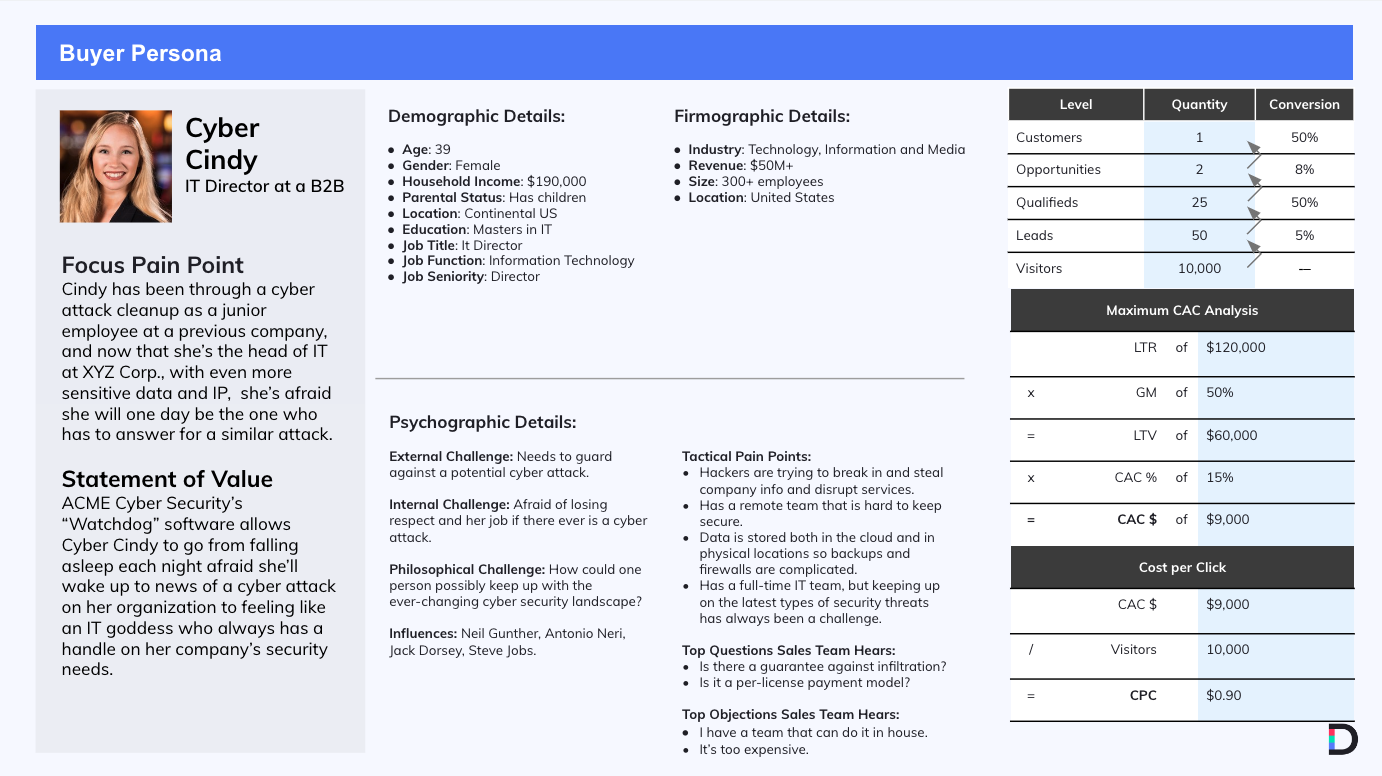Generate Demand: Start with a Pain-Point-Focused Buyer Persona
by Joseph Freeman | Updated Mar 30, 2024
Most buyer personas are highly detailed, including a lot of demographic data (often anecdotal with little research 😉)...
...and are sitting in a drawer collecting dust!
Unless your buyer personas are hyper-specific and focused on a single pain point, your marketing messaging is no doubt lukewarm and ineffective.
If you're not getting the type of responses to your ads and landing pages that you're hoping for, here are a few tips that have made our buyer personas way more useable:
Image: Example of a Digitopia pain-point-focused buyer persona.
Pare down your buyer persona demographics
You can go to town on your demographics. But at the end of the day, who's actually using them?
Most likely your paid advertising team.
Try only including the main demographic data that your paid ads team actually has access to across in the platforms they're using :
Google Ads, Linked Ads, and Meta Ads demographics for B2B advertising
- Age
- Gender
- Household Income
- Parental Status
- Location
- Education
- Job Title
- Job Function
- Job Seniority
Google Ads, Linked Ads, and Meta Ads firmographics for B2B advertising
- Company Category (Like Fortune 500)
- Company Industry
- Company Revenue
- Company Size (Number of Employees)
- Company Location

Image: Example of a Digitopia buyer persona demographics.
Should I Include colorful details to round out my buyer persona as an actual avatar?
No.
Listing superfluous avatar info like the number of children they have, where they went to college, or what their favorite food or drink is just doesn't help. Your ads team can't target well with that info and your copywriters won't be speaking to any relevant pain points if they focus on made-up info like that.
Save those traits for your D&D character.
Include the buyer's pain points
Now you need a list of the major pain points for which your product or service solves.
This is just a bulleted list. Not every buyer will have every pain point, but your sales team, advertising team, and copywriters will need to understand it since they'll likely be speaking to a cohort of B2B buyers in some of their marketing materials.
If you're marketing to an IT Director and selling software that prevents cyber attacks, the pain points you list might look something like this:
- Hackers are trying to break in and steal company info and disrupt services.
- Has a remote team that is hard to keep secure.
- Data is stored both in the cloud and in physical locations so backups and firewalls are complicated.
- Has a full-time IT team, but keeping up with the latest types of security threats has always been a challenge
One of these is likely the most common paint point. You'll grab that one and use it as your "focus pain point" which will guide the creation of your "Statement of Value" which will cover in just a bit.

Image: Example of a Digitopia buyer persona demographics.
Include the buyer's challenges
Wait! Didn't we just do this?
Not exactly.
We listed pain points that align with the "external" challenges. The obvious problems they're trying to solve.
But let's take that a step further to really empower your copywriters.
This is the part that most personas are missing. We're taking a page straight from Donald Miller's Building a Storybrand here and I've found it to be an invaluable bit of info to guide our copywriters.
Include the external, internal, and philosophical challenges in your buyer persona
External Challenge
The external challenge is about the actual, real-world threats and obstacles that a business faces.
These are the tangible problems that prevent a business from feeling safe and will be directly related to one of the pain points you listed above.
Your advertising should speak to the fact that your product or service can solve this problem for your buyer.
Example: "Needs to guard against a potential cyber attack to protect company data."
Internal Challenge
The internal challenge is about the stress and the worry your buyer is feeling.
It's about the fear of losing trust from customers or feeling embarrassed if something goes wrong. This is usually just inside your buyer's mind. They may or may not be talking about it externally.
Your advertising should speak to the fact that your product or service will bring peace of mind to your buyer.
Example: "Afraid of losing respect (and her job) if there ever is a cyber attack."
Philosophical Challenge
This challenge is about connecting with the deeper values and principles that motivate your buyer when it comes to this problem.
The philosophical challenge here dives into the bigger reason why solving this problem matters. Beyond the immediate worry of being hacked, there's a larger question of what's at stake—like the belief in privacy, the right to operate a business without interference, and the trust that customers place in a company.
Your advertising should speak to the fact that your product/service and company align witht he fundamental beliefs that your buyer holds.
Example: "It's unfair to expect one person to keep up with the ever-changing cyber security landscape without a little — or a lot of — outside help."

Image: Example of a Digitopia buyer persona challenges.
Create a "Statement of Value"
Go back to your list of pain points and pick one to focus most of your marketing efforts around.
You will run campaigns speaking to all of the listed pain points, especially if you're installing on a true demand generation effort. But, for the purpose of our buyer persona, you need to pick one and help your copywriters understand the "before" and "after" states your buyer will experience.
Here's the formula for writing a "Statement of Value":
[YOUR COMPANY]’s [PRODUCT/SERVICE] allows [PERSONA] to go from feeling [BEFORE STATE] to [AFTER STATE].
And this is what your "statement of value" should read like...
"ACME Cyber Security’s Watchdog software allows Cyber Cindy to go from falling asleep each night afraid she’ll wake up to the news of a cyber attack on her organization to feeling like an IT goddess who always has a handle on her company's security needs."
Include the most common questions your sales team hears
Finally, you should get ahead of some of the commonly asked questions and objections you'll hear later in the buyer's journey.
Example questions might be...
- Is there a guarantee against infiltration?
- Is it a per-license payment model?
- How long does it take to get set up?
Example objections might be...
- I have a team that can do it in-house.
- It’s too expensive.
- I like it, but I don't think we need it until next year.
To understand what these questions look like for your company simply ask your sales team.
They're on the front lines every day and likely get the same types of questions day in and day out. Pick the top two or three and add them to your buyer persona and make sure your marketing team is speaking to these in their messaging.
How to get started with your new buyer persona today
- Go grab that dusty ol' buyer persona out of the drawer and spruce it up.
- Round up your sales and marketing teams and pass out a copy to each. Ask them to tape it on the wall above their monitor to keep it top-of-mind.
- Audit all your current ads and marketing collateral to make sure your not speaking to your product/services features and instead speaking to your buyer persona's actual pains.









